Files in this item
The abundance of ultra-diffuse galaxies from groups to clusters : UDGs are relatively more common in more massive haloes
Item metadata
| dc.contributor.author | Burg, Remco F. J. van der | |
| dc.contributor.author | Hoekstra, Henk | |
| dc.contributor.author | Muzzin, Adam | |
| dc.contributor.author | Sifon, Cristobal | |
| dc.contributor.author | Viola, Massimo | |
| dc.contributor.author | Bremer, Malcolm N. | |
| dc.contributor.author | Brough, Sarah | |
| dc.contributor.author | Driver, Simon P. | |
| dc.contributor.author | Erben, Thomas | |
| dc.contributor.author | Heymans, Catherine | |
| dc.contributor.author | Hildebrandt, Hendrik | |
| dc.contributor.author | Holwerda, Benne W. | |
| dc.contributor.author | Klaes, Dominik | |
| dc.contributor.author | Kuijken, Konrad | |
| dc.contributor.author | McGee, Sean | |
| dc.contributor.author | Nakajima, Reiko | |
| dc.contributor.author | Napolitano, Nicola | |
| dc.contributor.author | Norberg, Peder | |
| dc.contributor.author | Taylor, Edward N. | |
| dc.contributor.author | Valentijn, Edwin | |
| dc.date.accessioned | 2018-01-19T13:30:09Z | |
| dc.date.available | 2018-01-19T13:30:09Z | |
| dc.date.issued | 2017-11 | |
| dc.identifier | 252095721 | |
| dc.identifier | f876b182-2b67-4bda-9906-a0361d021004 | |
| dc.identifier | 85034418977 | |
| dc.identifier | 000415765100002 | |
| dc.identifier.citation | Burg , R F J V D , Hoekstra , H , Muzzin , A , Sifon , C , Viola , M , Bremer , M N , Brough , S , Driver , S P , Erben , T , Heymans , C , Hildebrandt , H , Holwerda , B W , Klaes , D , Kuijken , K , McGee , S , Nakajima , R , Napolitano , N , Norberg , P , Taylor , E N & Valentijn , E 2017 , ' The abundance of ultra-diffuse galaxies from groups to clusters : UDGs are relatively more common in more massive haloes ' , Astronomy & Astrophysics , vol. 607 , A79 . https://doi.org/10.1051/0004-6361/201731335 | en |
| dc.identifier.issn | 0004-6361 | |
| dc.identifier.other | ArXiv: http://arxiv.org/abs/1706.02704v2 | |
| dc.identifier.uri | https://hdl.handle.net/10023/12527 | |
| dc.description.abstract | In recent years, many studies have reported substantial populations of large galaxies with low surface brightness in local galaxy clusters. Various theories that aim to explain the presence of such ultra-diffuse galaxies (UDGs) have since been proposed. A key question that will help to distinguish between models is whether UDGs have counterparts in host haloes with lower masses, and if so, what their abundance as a function of halo mass is. We here extend our previous study of UDGs in galaxy clusters to galaxy groups. We measure the abundance of UDGs in 325 spectroscopically selected groups from the Galaxy And Mass Assembly (GAMA) survey. We make use of the overlapping imaging from the ESO Kilo-Degree Survey (KiDS), from which we can identify galaxies with mean surface brightnesses within their effective radii down to ~25.5 mag arcsec-2 in the r band. We are able to measure a significant overdensity of UDGs (with sizes reff ≥ 1.5 kpc) in galaxy groups down to M200 = 1012 M⊙, a regime where approximately only one in ten groups contains a UDG that we can detect. We combine measurements of the abundance of UDGs in haloes that cover three orders of magnitude in halo mass, finding that their numbers scale quite steeply with halo mass: NUDG(R < R200) ∝ M2001.11±0.07. To better interpret this, we also measure the mass-richness relation for brighter galaxies down to Mr* + 2.5 in the same GAMA groups, and find a much shallower relation of NBright(R < R200) ∝ M2000.78±0.05. This shows that compared to bright galaxies, UDGs are relatively more abundant in massive clusters than in groups. We discuss the implications, but it is still unclear whether this difference is related to a higher destruction rate of UDGs in groups or if massive haloes have a positive effect on UDG formation. | |
| dc.format.extent | 13 | |
| dc.format.extent | 2411669 | |
| dc.language.iso | eng | |
| dc.relation.ispartof | Astronomy & Astrophysics | en |
| dc.subject | Galaxies: dwarf | en |
| dc.subject | Galaxies: formation | en |
| dc.subject | Galaxies: evolution | en |
| dc.subject | Galaxies: structure | en |
| dc.subject | Galaxies: groups: general | en |
| dc.subject | Galaxies: clusters: general | en |
| dc.subject | QB Astronomy | en |
| dc.subject | QC Physics | en |
| dc.subject | 3rd-DAS | en |
| dc.subject.lcc | QB | en |
| dc.subject.lcc | QC | en |
| dc.title | The abundance of ultra-diffuse galaxies from groups to clusters : UDGs are relatively more common in more massive haloes | en |
| dc.type | Journal article | en |
| dc.contributor.institution | University of St Andrews. School of Physics and Astronomy | en |
| dc.identifier.doi | 10.1051/0004-6361/201731335 | |
| dc.description.status | Peer reviewed | en |
| dc.identifier.url | http://arxiv.org/abs/1706.02704v2 | en |
This item appears in the following Collection(s)
Items in the St Andrews Research Repository are protected by copyright, with all rights reserved, unless otherwise indicated.

